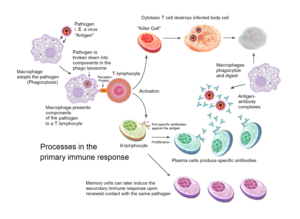Immune Health Part 2

Immune Part Two:
Dr. Claire Arcidiancono
In our last blog we went over the innate immune system and how it works. In this blog we will be reviewing the adaptive immune system as well as inflammation. Lastly I will be doing a walk through the immune system as it faces an infection.
The adaptive immune system is also referred to as the acquired immune system. In contrast to the innate immune system the adaptive immune system is highly specific to each pathogen it meets. This type of immunity often lasts a lifetime. It is actually the reason that vaccination works to protect us from infections. (1)
To start with antibodies are a critical part of the adaptive immune system. To start with I want you to think of the word “antigen” as being another way of saying “bad guys”. The antibody which is a y shaped protein has a unique part called the epitope. This allows the antibody to “tag” different antigens so that other parts of the immune system can kill it. In some cases the antibody can neutralize the “bad guys” directly. For example in some cases the antibody may block part of the virus that is important for the viral reproduction. There are 5 classes of antibodies – these are referred to as IgA, IgD, IgE, IgG and IgM. While the bodies of each class of antibody are all the same the antigen binding site or the ends of the y shape are all different. This is what allows the immune system to recognize millions of different antigens. These antibody classes differ in where they are released and when. (2)
Antibodies travel the body in 2 different ways. They can be attached to a B cell or free floating. Now this is an interesting part of the adaptive immune system. After an antigen binds to an antibody attached to a B cell (which is known as a B- cell receptor) the B cell turns on if you will. (3) In other words it actually starts to reproduce antibodies that are just like the one that “caught the antigen” and/or it will start to produce what are known as memory B cells. Memory B cells basically circulate the blood stream looking for the antigen they match. If they encounter it then they will go through the process of triggering a response from the immune system. (4) Antibodies that are not attached to B cells are considered soluble and are found in secretions such as blood and other bodily fluids. (3)
In a similar way of working to B cells there are T cells. To sum up the concept of B cells and T cells I just want to say this – these are the type of cells that work with antibodies to create memory cells known as memory B cells and memory T cells and this is what allows long lived specific immunity. (5)
While the adaptive immune system can get much more complicated that just what I’ve presented here I really wanted to keep this blog on a level that more easy to comprehend for everyone. Moving on what is inflammation? The main signs of inflammation which include redness, swelling, heat and pain are all caused by the injured or infected cells releasing something called eicosanoids and cytokines. The eicosanoids produce fever, increase the blood flow to an area, and attract different types of WBC. (6) Common cytokines are responsible for communication between the different types of WBC. Cytokines can also release growth factors and even recruit other immune cells to the sites of infection. (7) Where does autoimmune fit into this picture? All cells except red blood cells have antigens that tell the immune system hey it’s me don’t attack! Don’t attack your own body silly! In autoimmune there is a dysregulation in this recognition process and the body doesn’t recognize itself as itself and thus attacks. (8)
In this last section I am going to include a picture of a pathogen being attacked by the immune system.
(9)

- The innate and adaptive immune systems. Institute for Quality and Efficiency in Health Care (Iwi). 4 August 2016.
- Janeway CA, Travers P, Walport M, Shlomchik MJ (2001). Immunobiology (5th ed.). New York and London: Garland Science. ISBN 0-8153-4101-6.
- Borghesi L, Milcarek C (2006). “From B cell to plasma cell: regulation of V(D)J recombination and antibody secretion”. Immunologic Research. 36 (1–3): 27–32. doi:10.1385/IR:36:1:27. PMID 17337763. S2CID 27041937.
- Weisel F, Shlomchik M (April 2017). “Memory B Cells of Mice and Humans”. Annual Review of Immunology. 35 (1): 255–284. doi:10.1146/annurev-immunol-041015-055531. PMID 28142324.
- https://en.wikipedia.org/wiki/Memory_T_cell
- Ogawa Y, Calhoun WJ (October 2006). “The role of leukotrienes in airway inflammation”. The Journal of Allergy and Clinical Immunology. 118 (4): 789–98, quiz 799–800. doi:10.1016/j.jaci.2006.08.009. PMID 17030228.
- Vijay K (June 2018). “Toll-like receptors in immunity and inflammatory diseases: Past, present, and future”. Int Immunopharmacol. 59: 391–412. doi:10.1016/j.intimp.2018.03.002. PMC 7106078. PMID 29730580.
- Miller JF (1993). “Self-nonself discrimination and tolerance in T and B lymphocytes”. Immunologic Research. 12 (2): 115–30. doi:10.1007/BF02918299. PMID 8254222. S2CID 32476323.
- https://upload.wikimedia.org/wikipedia/commons/4/41/Primary_immune_response_1.png